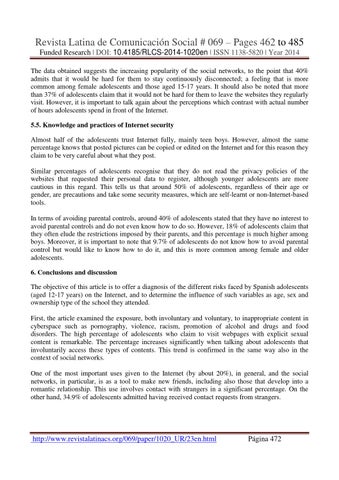Revista Latina de Comunicación Social # 069 – Pages 462 to 485 Funded Research | DOI: 10.4185/RLCS-2014-1020en | ISSN 1138-5820 | Year 2014 The data obtained suggests the increasing popularity of the social networks, to the point that 40% admits that it would be hard for them to stay continuously disconnected; a feeling that is more common among female adolescents and those aged 15-17 years. It should also be noted that more than 37% of adolescents claim that it would not be hard for them to leave the websites they regularly visit. However, it is important to talk again about the perceptions which contrast with actual number of hours adolescents spend in front of the Internet. 5.5. Knowledge and practices of Internet security Almost half of the adolescents trust Internet fully, mainly teen boys. However, almost the same percentage knows that posted pictures can be copied or edited on the Internet and for this reason they claim to be very careful about what they post. Similar percentages of adolescents recognise that they do not read the privacy policies of the websites that requested their personal data to register, although younger adolescents are more cautious in this regard. This tells us that around 50% of adolescents, regardless of their age or gender, are precautions and take some security measures, which are self-learnt or non-Internet-based tools. In terms of avoiding parental controls, around 40% of adolescents stated that they have no interest to avoid parental controls and do not even know how to do so. However, 18% of adolescents claim that they often elude the restrictions imposed by their parents, and this percentage is much higher among boys. Moreover, it is important to note that 9.7% of adolescents do not know how to avoid parental control but would like to know how to do it, and this is more common among female and older adolescents. 6. Conclusions and discussion The objective of this article is to offer a diagnosis of the different risks faced by Spanish adolescents (aged 12-17 years) on the Internet, and to determine the influence of such variables as age, sex and ownership type of the school they attended. First, the article examined the exposure, both involuntary and voluntary, to inappropriate content in cyberspace such as pornography, violence, racism, promotion of alcohol and drugs and food disorders. The high percentage of adolescents who claim to visit webpages with explicit sexual content is remarkable. The percentage increases significantly when talking about adolescents that involuntarily access these types of contents. This trend is confirmed in the same way also in the context of social networks. One of the most important uses given to the Internet (by about 20%), in general, and the social networks, in particular, is as a tool to make new friends, including also those that develop into a romantic relationship. This use involves contact with strangers in a significant percentage. On the other hand, 34.9% of adolescents admitted having received contact requests from strangers.
http://www.revistalatinacs.org/069/paper/1020_UR/23en.html
PĂĄgina 472
